Gamification in action
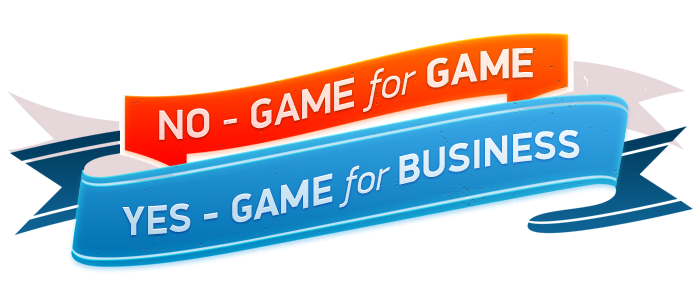
What is it all about
Lately they talk a lot about gamification. They talk about the essence of technology and the history of occurrence, describe the mechanics, cite as an example Foursquare, collect statistics and conduct surveys. There is enough theory in the network, but there are few good examples of gamification in business. This article aims to show, using the example of LiveTex, how you can organically fit the gamification tools into the company's business processes.
About company
LiveTex is a Russian IT-company, whose own-developed products allow communication of website visitors with its owners, thereby increasing the conversion of an Internet resource. Inside the company there are several departments of managers that directly interact with customers: departments of attraction, sales, support, key customers and technical support. The organization strives to improve the quality of its business processes, therefore it uses various KPIs, collects statistics on employee actions and controls the situation with the help of regulations. Inside the company, employee ratings are conducted by department, there are leaderboards, regulations regulate the transfer to new positions, and bonus employees are directly proportional to their achievements.
Formulation of the problem
LiveTex has been working very effectively over the past few years, steadily increasing its customer base. Employees are constantly improving their skills, interacting with customers from different areas of production and services, and are deeply involved in the work of the company, offering their ideas for improving products and optimizing business processes. The company tries to look for only the best personnel for maximum productivity and productivity, creating a strong team. Award system, corporate university, billiards, darts, kicker, corporate parties, free meals twice a week and much more give their positive results.
But how to achieve great results? How to make employees even routine routine activities interesting? How to make so that the motivation does not fall even during the gray St. Petersburg weather and bad mood? How to make the employees even more eager to develop their professional skills? In the end, how to make employees to earn more by helping to earn the company itself?
')
One day, the organization decided to turn its attention to gamification.
Business requirements
The company has been on the market for several years and has been successfully developing on it, and understands that creating features for the sake of the features themselves is irrational and often leads only to increased costs. Therefore, before making a fuss, the company decided to determine for itself what should grow on it and outlined the following business goals:
- Increasing the speed of mastering the functionality of the company's products by new employees. The criterion for the success of the goal is to pass a test on the knowledge of the product for a period less than the current average.
- Increase the productivity of employees and departments. The criterion for the success of the goal is the change in the corresponding KPI of employees and departments in comparison with the current level in a positive direction.
- Increased employee motivation, corporate spirit and involvement in the company's workflow. The criterion for the success of the goal is to increase the complex indicator, consisting of:
- the number of posts, discussions and likes in the corporate network;
- the number of ideas generated to improve the company's business processes or the functionality of its products;
- the number of positive customer feedback on the quality of service;
- Minimize the processing time of employees' indicators by automating the collection and storage of information, as well as generating reports for decision-making. The criterion for the success of the goal is to reduce the time of daily operations associated with the described processes.
Having determined the goals, the company thought about the rules of the game.
Gamification
What is gamification? This is the use of game mechanics in a non-player context. Any process is presented as a game played by participants in the process, or players. The exit process is a victory in the game, or the execution of a quest, or getting some achievement. Any business process is strictly deterministic, i.e. The rules of the game are transparent, simple and understandable to the players. Making moves, players achieve certain results. Players can plan their moves by implementing a particular strategy. Fulfilling the rules of the game according to the chosen strategy, ultimately, the players must achieve victory.
In addition to the rules of gamification, the company has identified several concepts that it would like to support in the development process:
- All awards that will be awarded to players must be given only for what is the value to the company;
- The game should be fun for the players and increase their motivation, so there should not be fines and penalties, and the guaranteed minimum wage should be maintained regardless of the outcome of the game;
- The game should gradually immerse players in the context, and the objectives become more complex as the players gain experience;
- The game should be a continuation of the company's business processes, and not an independent entity;
- Players must see game results in real time;
- Players should be able to see their growth statistics;
- Each player is an individual.
Taking the position of gamification, the concepts put forward and its own business processes as a basis, the company chose the mechanics with which the set business goals should be achieved.
Employee account

In the center of any game is a player. It is through him that the game is realized. Therefore, the company placed an employee in the center of the system. Each employee has his own account that characterizes him as a player. The account consists of several parts: information on the employee, his achievements in the form of badges, statistics aggregated by employee indicators, the level achieved, the number of points earned.
An employee account is designed for several purposes. First, information on the employee is necessary for other employees of the company and may contain such useful information as the employee's photo and full name, hobbies, information about education, contact details, position in the organization, work duties, location of the employee in the company building. Secondly, an employee in his account can observe his progress in the professional field in real time, thereby realizing his growth. Thirdly, the employee’s account displays a system of levels and their achievement depending on the assigned tasks, using which the employee can plan his actions to move to a new level.
Level system

The company decided to adapt several of its regulations regarding work processes, and built a system of employee growth levels depending on which department they work in. For example, for the department of attracting significant KPI is the number of attracted customers at various stages of the sales funnel, and for the support departments - the number of successful customer consultations. The company presented the system of levels in the form of a tree, on which the key points are indicated - levels. For each key point, it is determined what the employee needs to do to achieve it. For example, attract a hundred customers who will test the product.
Reaching a level gives an employee a certain amount of game points that he can spend in a special store. In some cases, the achievement of a particular level opens up new opportunities for the employee, which he can use. For example, an employee has reached a certain level, which is possible only with a large number of processed chats and successful consultations, and in fact is a guarantee that this employee is really good. In this case, the achievement of this level opens up a new opportunity for the employee - increases the number of simultaneously processed chats, or gives the employee the right to use irregular work schedules, or the employee receives personal business cards for use. At the same time, the difficulty of reaching the next levels increases.
As a result, the system of levels allows the employee to understand what actions he needs to do in order to improve himself as a professional within the company, and due to the increased complexity his interest in the game continues to remain at a constant level.
Growth statistics
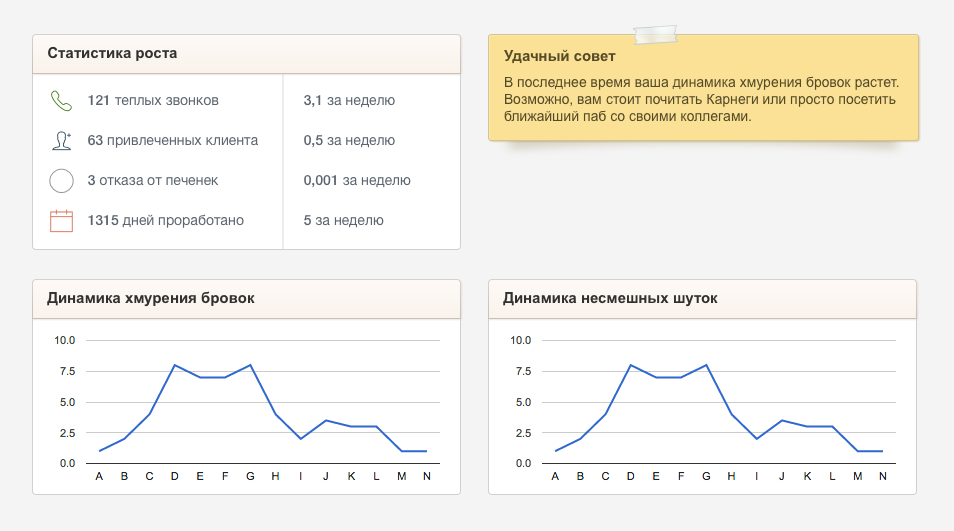
There is nothing more positive than watching how your performance grows as you play, how every day you get steeper and steeper. Therefore, the company decided to open for each employee their indicators, which are aggregated to calculate various KPIs. Growth statistics include not only real employee performance, but also those that the company expects to receive from it. Employee growth statistics are an important tool for analysis for both the company and the employee. In case of good indicators relative to the required ones, the employee receives additional points, and in case of bad ones, an additional employee training system is activated. For example, if an employee’s development dynamics are below average, the system advises him to familiarize himself with these or other educational materials that will help him increase his achievements, or re-take some tests.
Feedback
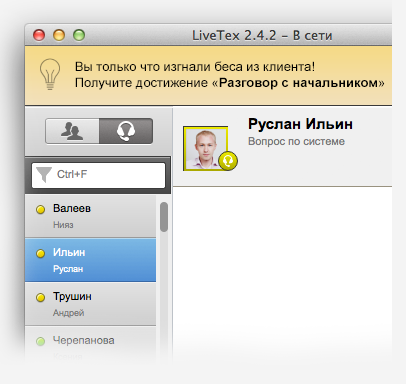
In the company, employees use several core products for their work: operator's console, corporate CRM, software for calling customers. The operator’s console is required for direct communication with site visitors and between operators, and in CRM, employees perform various tasks assigned to customers. Customer Calling Software and Africa Customer Calling Software.
Using all this software, employees change some of their indicators (number of chats, duration of voice calls, task execution time, etc.). For a moment, someone from the top management of the company imagined that he was sitting all day in the operator’s console and did not see anything except a series of almost identical dialogues with visitors. He didn’t like this passing vision, and the company decided to show their achievements in real time to their employees. Employees must understand that every action they make adds another coin to their bank. Reflection is formed only when a clear response of the environment to your actions.
Badges

Badges the company has chosen as another gaming tool for displaying employee growth. An employee can receive badges for various things: for obtaining a level, for achieving a certain indicator that is valuable for the company, for intra-corporate competitions, for individual achievements, for passing tests, etc. Badges are given not only automatically, they can be assigned manually by the top management of the company for the special success of the employee:
- The employee worked in the company for one month / quarter / year / 3 years;
- The employee processed 100/1000/10000 chats;
- The employee attracted 10/20/30/50/100 customers;
- The employee reached the 5/10/15/20 level;
- The employee won the idea contest one / two / three / five times;
- The employee earned the Bug Catcher achievement;
- The employee earned the “Best Cheburek of the Week” achievement.
Quests
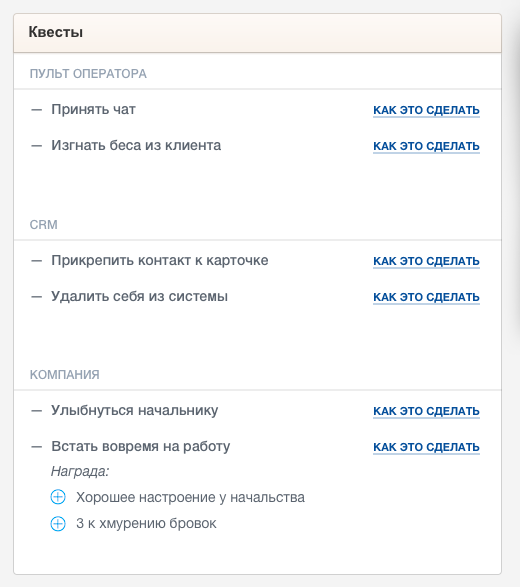
Quests are the game element, which gives the game playability. Quest is a task with a detailed description that must be completed in order to continue the game. Completing all quests guarantees victory in the game. Since victory in the game from the point of view of business goals is in principle impossible, the quests in the company are used at first to train new employees in the functionality or training of employees of the new functionality. All quests are divided into groups depending on the functionality of the products, and their execution is sorted from simple to complex. Another division of quests in the company - on disposable and permanent. One-time quests include quests that an employee needs to complete only once. For example, take the first call or transfer the first time chat to another employee. Regular quests are usually optional, so an employee can perform them several times. These include quests for an appointment, in which to perform them you must return to the game at a certain time to perform some action, for example, to come to work by 9.00. At the same time, the number of points earned on the quest increases, depending on how successfully the quest was performed in the past.
Promotions and surprises
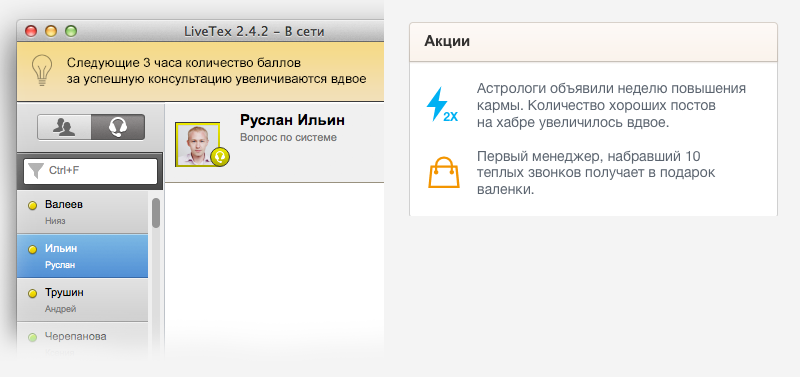
Another element of gamification to increase the productivity of employees, the company chose the mechanics of temporary events. A temporary event is non-permanent and occurs in a game that is not permanent. Events of such a plan are divided into promotions and surprises. Stocks include temporary events that a company uses to increase employee or department performance when it observes an overall decrease in results. For example, the action, which increases by three times the points for attracting new customers in the next two days. Surprises are a variant of stocks that occur randomly with a given frequency factor.
Tests

Tests have become the company's main method for certifying their employees, be it knowledge of the functional, regulations, subject area, key clients, etc. Successful passing of tests is a prerequisite for reaching certain levels. The company welcomes the employees to repeat the tests, although for this a much smaller number of points is awarded compared to the first time. Some tests are required to re-pass.
Shop for spending points

For a lot of things, employees get points, which are essentially gaming virtual currency that they can spend at their discretion in a special store. The company very carefully approached the construction of the store's range, leaving only those goods and services that are directly related to the company's activities. No chocolates, subwoofers and mimishechek. Only that can help the employee in his workflow. For example, an employee may spend his points on:
- T-shirt or sweatshirt with the company logo;
- A cup for tea or coffee with the company logo;
- The literature associated with his profile;
- Ordering pizza to the office;
- Excess time off;
- High-quality headset with a company logo for making calls;
- Cell phone, tablet, laptop;
- etc.
Leaderboards
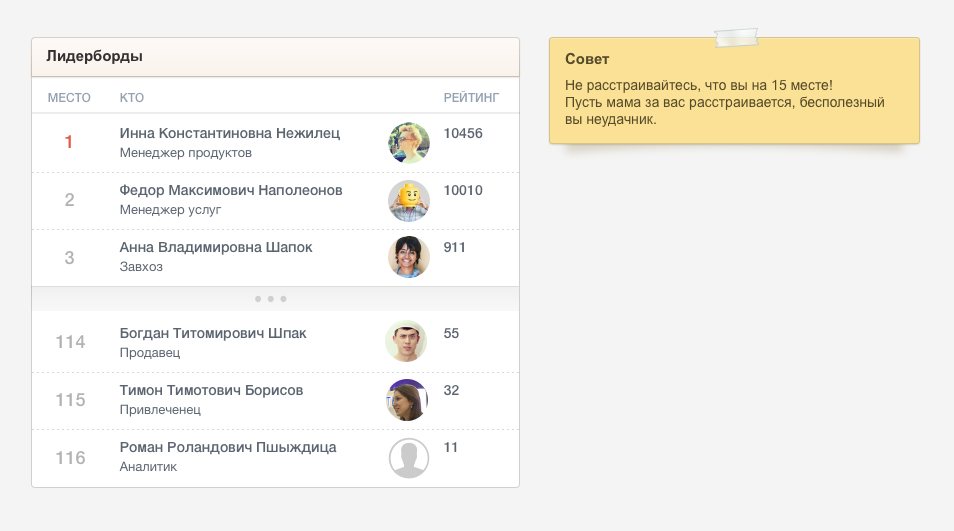
Leaderboards were already in the company before the introduction of the mechanic of gamification. Leaderboards themselves are quite contradictory. Despite the fact that they encourage competition, and as a result of productivity, they can also reduce it. On the one hand, it is nice to observe yourself in the top lines of the overall rating, and on the other, the motivation in this case, the last lines tends to zero. The solution to the problem was the use of a general leaderboard and leaderboard, which reflects the position of the employee in the rating only together with employees with similar results.
Results of implementation
And now the fun part. As you already understood, in reality, there is nothing like that at LiveTex, and the entire previous post was presented as an example of rational use of gamification mechanics depending on the goals set by the business. We hope that some companies, after reading this article, will take a closer look at the capabilities of the game mechanic and will try to experiment with them in their business. And if not for the sake of business requirements, then just for fun.
Source: https://habr.com/ru/post/203054/
All Articles